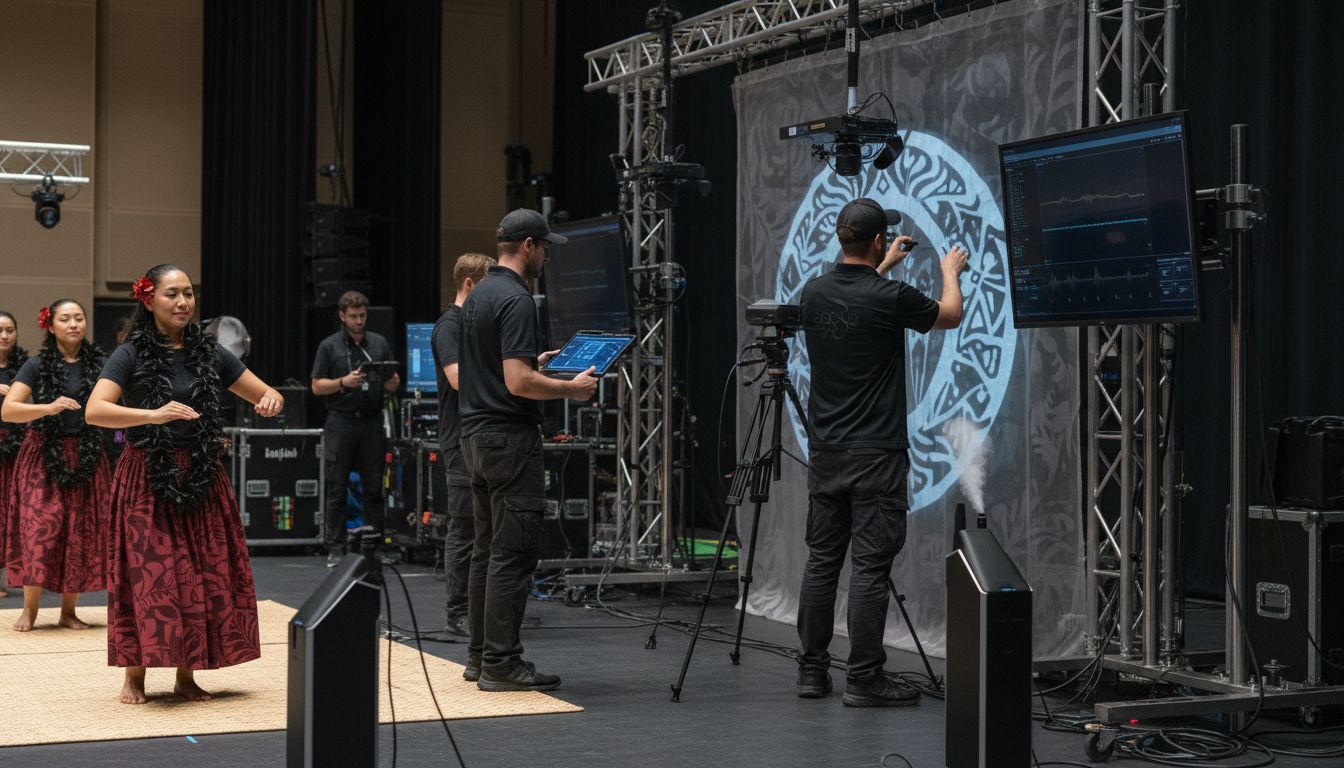What Sets Hawaiian Theater Apart: Complete Guide

Over 1,500 years of storytelling come alive every time Hawaiian theater takes the stage. This living tradition is more than performance art. It preserves ancient legends, celebrates oral histories, and honors spiritual rituals in ways unlike any other culture. Whether you are fascinated by immersive experiences or curious about authentic island heritage, exploring Hawaiian theater reveals a world where music, movement, and memory shape a truly unforgettable journey.
Table of Contents
- Defining Hawaiian Theater And Its Origins
- Immersive Technology And Sensory Experiences
- Cultural Storytelling And Native Legends
- Comparisons To Traditional And Global Theater
- Audience Appeal: Families, Tourists, And Locals
Key Takeaways
| Point | Details |
|---|---|
| Hawaiian Theater as Cultural Archive | Hawaiian theater is a vital tradition that preserves ancestral wisdom, oral histories, and cultural memory through storytelling, music, and dance. |
| Innovative Immersive Experiences | The integration of technology in Hawaiian theater enhances audience engagement, allowing for a multisensory exploration of cultural narratives. |
| Preservation of Native Legends | Performances serve as living conduits for traditional stories, connecting generations and maintaining the spiritual and cultural identity of Hawaiian people. |
| Broad Audience Appeal | Hawaiian theater attracts diverse audience segments, offering interactive experiences that resonate with families, tourists, locals, and cultural enthusiasts. |
Defining Hawaiian Theater and Its Origins
Hawaiian theater represents a profound cultural storytelling tradition that transcends mere entertainment, embodying the rich narrative heritage of the Hawaiian Islands. Far more than a performance, it serves as a living archive of ancestral wisdom, oral histories, and cultural memory. The roots of Hawaiian theatrical expression run deep, intertwining music, dance, chant, and visual storytelling in ways that are uniquely indigenous.
The historical development of Hawaiian theater can be traced back to traditional hula performances and mo’olelo (storytelling) practices that predated Western contact. These early performances were not just artistic expressions but sacred cultural rituals that preserved genealogies, historical events, and spiritual connections. Hawaii Theatre, established in 1922 in Honolulu, represents a significant milestone in the architectural and performative evolution of Hawaiian theatrical spaces, blending Neoclassical and Art Deco styles that reflect the cultural fusion of the islands.
Modern Hawaiian theater continues to honor traditional storytelling while incorporating contemporary performance techniques. Key characteristics that distinguish Hawaiian theater include:
- Emphasis on cultural authenticity
- Integration of native Hawaiian language
- Storytelling that centers indigenous perspectives
- Performative styles that prioritize community connection
- Narrative structures rooted in oral tradition
For those interested in exploring the nuanced world of Hawaiian storytelling experiences, Hawaiian Storytelling Experiences provides a comprehensive overview of contemporary performative traditions that continue to keep this vibrant cultural practice alive and evolving.
Immersive Technology and Sensory Experiences
Hawaiian immersive theater represents a groundbreaking fusion of cutting-edge technology and traditional storytelling, transforming audience experiences through multisensory engagement. By leveraging advanced technologies, these performances transcend conventional theatrical boundaries, creating deeply interactive and emotionally resonant narratives that transport audiences directly into the heart of Hawaiian culture.
Research from drpress reveals how immersive theatre fundamentally transforms audience engagement by integrating multi-sensory elements that enhance spatial, narrative, and emotional involvement. In Hawaiian context, this means audiences don’t just watch a performance they become active participants in living, breathing cultural experiences that stimulate all sensory dimensions.
The technological innovations driving these immersive experiences include:
- Augmented reality overlays that blend digital and physical storytelling
- Sophisticated motion tracking systems
- 360-degree surround sound environments
- Scent and wind simulation technologies
- Interactive digital interfaces that respond to audience movements

For those eager to explore the most innovative immersive experiences Hawaii offers, Immersive Tours Hawaii provides an extraordinary glimpse into how technology is revolutionizing cultural storytelling. These experiences go beyond traditional performance, creating personalized narratives that invite participants to become integral parts of the storytelling process.
Cultural Storytelling and Native Legends
Hawaiian theater is a profound vessel for preserving and celebrating the rich tapestry of native legends, transforming ancient stories into living, breathing performances that connect generations. These narratives are far more than entertainment they are sacred conduits of cultural memory, wisdom, and spiritual understanding that have sustained Hawaiian identity through centuries of change.
Hawaii Theatre has historically served as a critical platform for performances that breathe life into traditional storytelling, reflecting the islands’ deep cultural heritage. The theatrical space itself becomes a sacred ground where mo’olelo (traditional stories) are not just recounted but experienced, allowing audiences to journey through time and connect with the ancestral narratives that shape Hawaiian cultural consciousness.
The core elements of Hawaiian cultural storytelling include:
- Preservation of genealogical histories
- Transmission of traditional ecological knowledge
- Exploration of spiritual connections to land and nature
- Celebration of indigenous perspective
- Ritual reenactment of foundational mythological events
For those seeking to dive deeper into the nuanced world of Hawaiian narrative traditions, Understanding Hawaiian Culture in Entertainment offers an illuminating exploration of how these ancient storytelling practices continue to evolve and inspire contemporary performance art. Each legend, each performance becomes a living bridge connecting past wisdom with present understanding.
Comparisons to Traditional and Global Theater
Hawaiian theater emerges as a distinctive art form that defies traditional theatrical categorizations, blending indigenous storytelling techniques with innovative performance practices that set it apart from both Western and global theatrical traditions. Unlike conventional theater models that often prioritize scripted narratives and fixed staging, Hawaiian performances embrace a fluid, organic approach that transforms audience interaction and narrative delivery.
Hawaii Theatre exemplifies this unique theatrical fusion, showcasing architectural and performance styles that represent a remarkable synthesis of local cultural expressions and global influences. The venue itself becomes a testament to the dynamic nature of Hawaiian performance art, where architectural design mirrors the adaptive and interconnected storytelling philosophies fundamental to indigenous performance practices.
Key distinctions between Hawaiian theater and traditional global theater include:
-
Holistic storytelling that integrates performance, spirituality, and cultural education
-
Audience participation as a core performance element
-
Emphasis on collective narrative over individual character development
-
Performance spaces that are inherently sacred and communal
-
Prioritization of oral transmission over written script
-
Sensory and immersive experiences that transcend visual storytelling
For those intrigued by the nuanced world of Hawaiian theatrical traditions, Hawaii Themed Entertainment offers an illuminating exploration of how cultural performance continues to evolve, challenge, and redefine traditional theatrical boundaries.
Audience Appeal: Families, Tourists, and Locals
Hawaiian theater represents a unique cultural experience that transcends traditional entertainment boundaries, creating a magnetic attraction for diverse audience groups. From wide-eyed children to seasoned travelers and local residents, these performances offer something extraordinary that speaks to each demographic’s curiosity, emotional connection, and desire for authentic cultural immersion.
Hawaii Theatre exemplifies this broad audience appeal by offering performances that cater to varied interests and cultural backgrounds. The theatrical experience becomes a bridge connecting different generations and visitor types, transforming passive observation into active cultural engagement.
Audience segments find specific value in Hawaiian theater through:
- Families: Interactive storytelling that educates children about cultural heritage
- Tourists: Immersive experiences providing deeper understanding of Hawaiian traditions
- Locals: Performances that celebrate and preserve indigenous narratives
- Multi-generational groups: Shared experiences that create meaningful connections
- Cultural enthusiasts: Authentic representations of Hawaiian storytelling
For visitors seeking to understand the nuanced world of Hawaiian performance, Hawaiian Themed Entertainment offers an illuminating guide to experiencing these transformative cultural narratives that resonate across age groups and backgrounds.
Experience Hawaiian Theater Like Never Before with Flight of Aloha
The article highlights how Hawaiian theater stands out through cultural storytelling, immersive sensory experiences, and deep connections to native legends. If you are craving that powerful feeling of stepping inside a living story rather than just watching a show, Flight of Aloha offers exactly that. Their immersive flying theater attraction blends awe-inspiring 8K visuals, motion, scents, and wind to transport you over Hawaii’s stunning landscapes while honoring the rich Hawaiian traditions featured in the article.
This innovative experience is perfect for families, tourists, and locals seeking authentic cultural engagement wrapped in cutting-edge technology. Imagine not just hearing Hawaiian mo’olelo but feeling the spirit of the islands all around you. Flight of Aloha’s unique ride films like “Naupaka” and “Lahaina” deliver the kind of multisensory storytelling that the article describes as the future of Hawaiian theater.
Take your Hawaiian theater experience beyond words and reach out to a new dimension where culture meets technology. Ready to immerse yourself in the magic? Discover more and book your adventure at Flight of Aloha.

Dive deeper into Hawaii’s cultural stories through innovative immersive entertainment. Don’t miss the chance to make unforgettable memories that connect you with the heart of the islands. Experience it now by visiting Flight of Aloha and learn how our immersive tours bring Hawaiian legends to life. Your unforgettable Hawaiian theater journey starts here.
Frequently Asked Questions
What is Hawaiian theater and how does it differ from traditional theater?
Hawaiian theater is a distinctive art form that blends indigenous storytelling techniques, such as hula and mo’olelo, with contemporary performance practices. Unlike traditional theater, which often emphasizes scripted narratives and fixed staging, Hawaiian performances prioritize cultural authenticity, community connection, and immersive audience interaction.
How has modern technology influenced Hawaiian theater?
Modern technology has revolutionized Hawaiian theater through immersive experiences that incorporate augmented reality, motion tracking, and sensory elements like sound and scent. These innovations allow audiences to engage deeply with Hawaiian culture and storytelling, transforming them from passive viewers to active participants.
What are the core elements of Hawaiian cultural storytelling?
Core elements of Hawaiian cultural storytelling include the preservation of genealogical histories, transmission of ecological knowledge, exploration of spiritual connections to land and nature, and the enactment of indigenous perspectives through performance and rituals.
Who can benefit from experiencing Hawaiian theater?
Hawaiian theater appeals to a wide range of audiences including families, tourists, locals, multi-generational groups, and cultural enthusiasts. Each group benefits from interactive storytelling that educates, entertains, and enhances understanding of Hawaiian traditions.

